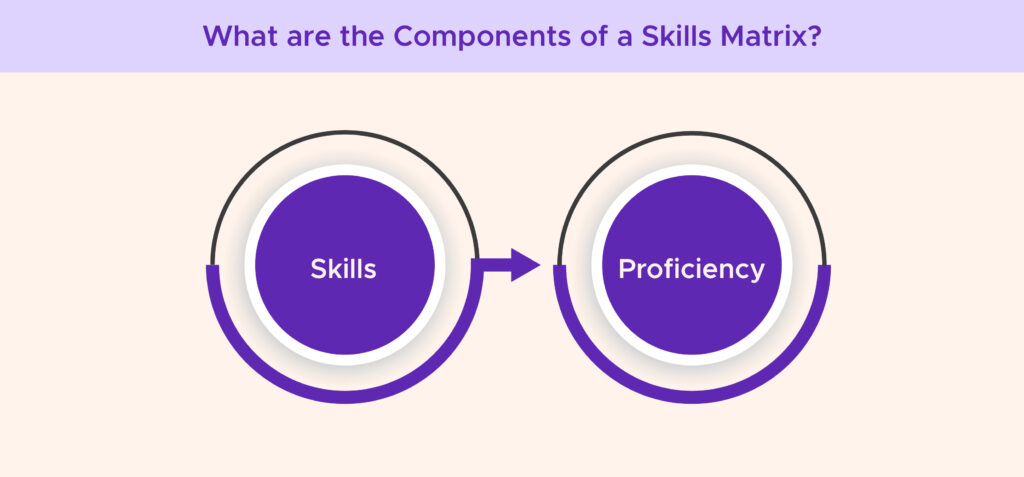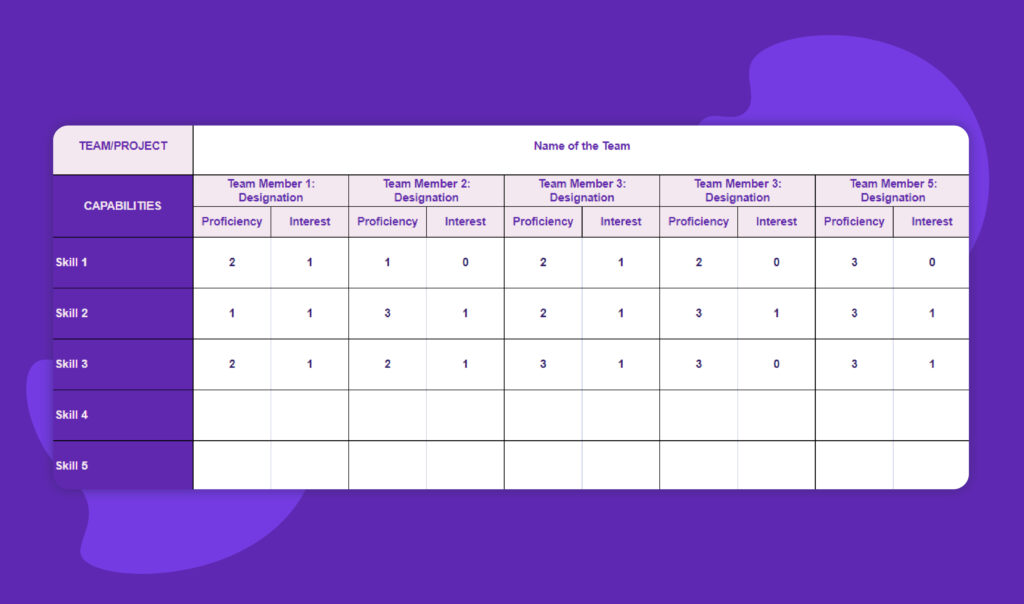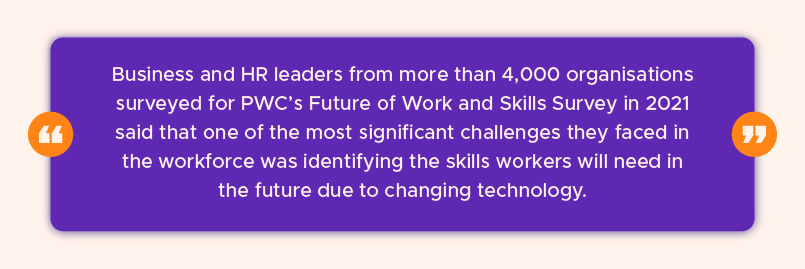
As businesses strive to stay competitive, it’s crucial to ensure that your team has the necessary skills to succeed.
A recent Deloitte survey found that over 75% of global board members and executives view the availability of skills and talent as a significant risk factor for their organizations.

However, identifying and addressing skill gaps can be a challenge. That’s where the skills matrix comes in – a valuable tool that helps you understand your team’s strengths and weaknesses, and develop targeted strategies for growth. In this blog post, we cover everything you need to know about the skills matrix for employees and share a free template you can use right away! Let’s get started.
A skills matrix, also known as a skill set matrix, is a visual tool designed to map and assess the skills and competencies of employees within an organization. It provides a clear overview of team members’ strengths and weaknesses, enabling organizations to identify skill gaps and development opportunities.
This information is invaluable for optimizing resource allocation, driving targeted talent development, and ultimately, enhancing overall team performance.

A well-constructed skills matrix is built on two key components: 1. Skills This section forms the foundation of your matrix, outlining all the relevant skills required for your team or project. These skills can be categorized into different groups for better organization: ⚙️ Technical Skills: These are hard skills specific to a particular job function.
Examples include software proficiency, coding languages, data analysis skills, or specialized equipment operation.🗣️ Soft Skills: These are transferable skills that contribute to overall workplace effectiveness.
Examples include communication, teamwork, problem-solving, critical thinking, or leadership.🏢 Industry-Specific Skills: Certain industries may require specialized knowledge or certifications.
For example, marketing teams might benefit from skills in social media management or SEO, while a legal team might need expertise in contract law or regulatory compliance.
2. Proficiency Levels This section defines different levels of expertise for the list of skills in the matrix. Common skill proficiency scales include: 👉 Beginner: Has a basic understanding of the skill but limited practical experience. 👉 Intermediate: Can perform tasks independently but may require some guidance or supervision. 👉 Advanced: Can proficiently apply the skill independently and solve complex problems. 👉 Expert: Has in-depth knowledge and mastery of the skill, acting as a mentor or resource for others.
When defining proficiency or competency levels, it’s crucial to establish clear criteria for each skill level. This ensures consistency in evaluations across team members and different evaluators. Consider incorporating specific examples, required knowledge, or successful completion of relevant projects as benchmarks for each level.


Below is an example of a skills matrix for a software development team, showcasing how skills are mapped against team members and their proficiency levels.
2.2: Define the Criteria
For each skill and proficiency level, establish specific criteria that outline what it means to be at that level. This could involve experience, knowledge, certifications, or past performance. Here’s an example:
Skill: Web Development

3.3: Open Communication
Encourage open communication throughout the assessment process. This allows team members to clarify any doubts and ensures a transparent approach.
4.1: Choose Your Platform
Decide on a format for your skills matrix. Simple tables work, but dedicated software can offer additional functionalities.
For example, Peoplebox offers a comprehensive OKR and performance management software that gives you a complete picture of your workforce. Try it yourself.
TAKE A TOUR4.2: Structure it Clearly
List the skills data across the top and team members down the side. Fill in the matrix by assigning each team member the appropriate proficiency level for each skill.
4.3: Visual Representation is Key
Consider using color coding or visual indicators to make the matrix easily understandable at a glance.
To make it easy for your team to be organized, we have created a simple skills matrix template you can use right away. With this you can:
👉 Map key skills: Brainstorm what your team needs to excel.
👉 Rate proficiency & interest levels: See who has the skills (and wants to grow them!).
👉 Develop action plans: Bridge skill gaps with targeted training.
👉 Track progress: Monitor improvement and adapt as needed.

Want to take your skills matrix to the next level and unlock the full potential of performance management?
Peoplebox offers a comprehensive solution that seamlessly integrates with skills assessment, streamlining performance reviews and identifying skill gaps with greater accuracy. This empowers you to make data-driven decisions for targeted employee development and continuous organizational growth.
Our user-friendly platform provides customizable features to seamlessly integrate with your existing HR processes, ensuring a positive experience for both team leaders and employees.
Take the first step towards optimizing your performance management strategy. Contact us today to learn more about how Peoplebox can transform your workforce into a high-performing and future-ready team.
To fill a skills matrix for employees, start by listing all relevant skills required for your team or project. Define clear proficiency levels (e.g., Beginner, Intermediate, Advanced) with specific criteria for each. Have team members conduct a self-assessment based on these criteria, followed by manager or peer assessments for additional input.
Regularly review and update the matrix to reflect skill development and evolving needs. Involve the team in the process to ensure accuracy and foster a sense of ownership.
Involve team members in identifying necessary skills and assessing their own proficiency levels through brainstorming sessions and self-assessments, fostering ownership and transparency. This will help them comprehend and use skills matrices better.
A skills matrix can be time-consuming to create and maintain, may oversimplify complex skills, and can become outdated quickly. It might also lead to overemphasis on listed skills, overlooking other valuable but unlisted abilities.
A skill matrix is utilized by HR professionals to identify skill gaps, plan training programs, and support recruitment. Managers and team leaders use it to assess team capabilities and allocate tasks effectively. Employees use it to understand their skill levels and plan career development.
Learning and Development specialists design targeted training programs based on it, while project managers ensure the right skills are available for project requirements and resource planning.
There are several types of skill matrices, including role-based, which lists skills required for specific roles and maps them to employees; team-based, focusing on skills within a team; project-based, highlighting skills needed for specific projects; competency-based, categorizing skills by proficiency levels; technical, concentrating on technical skills for IT or engineering departments; and functional, listing skills required across different functions or departments.